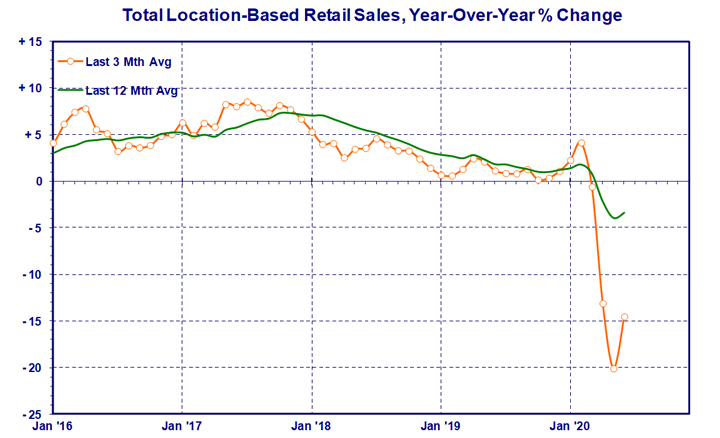Canadian Retail Sales Start to Crawl Back: Ed Strapagiel
/woman with shopping bags points at retail window display
By Ed Strapagiel
Although Canadian retail sales are still in bad shape for the most part, there are signs that things are beginning to turn around, according to the latest data from StatsCan. There's still a long way to go however, and we may never get back to the old pre-pandemic normal.
total location-based retail sales year over year % change
In Q2 of 2020, total Canadian retail sales declined 14.5% year-over-year. While this is probably the worst quarter ever, it's actually not as bad as the previous 3 month average. The above chart shows a rebound in the 3 month average retail sales growth rate (orange line) and a corresponding bounce in the underlying 12 month trend (green line).
Perhaps better still is that retail sales for June alone were up 4.8% versus a year ago on an unadjusted basis. This comes after being down an average of 20.0 % over March to May.
Food & Drug
food and drug retail sales year over year % change
The Food & Drug sector actually benefitted from COVID, because these retailers remained open, people were cooking and eating at home more, and shoppers were hoarding. This effect is now starting to cool off. Retail sales in Q2 were up an impressive 7.5% year-over-year, but the 3 month trend (orange line in the chart) now appears to be past its peak. While the underlying 12 month trend (green line) is still rising, it is likely to run out of steam in the coming months.
Supermarkets & other grocery stores had the strongest increase in Q2 2020. Their retail sales were up 14.0% year-over-year. Convenience stores also made a significant gain, up 13.7%.
Health and personal care stores however did not share the bounty. Their retail sales declined 4.3% in Q2. This category includes cosmetics, beauty supplies and perfume stores, opticians, and other retailers which may have been required to close due to the pandemic.
Store Merchandise
store merchandise retail sales year over year % change
The Store Merchandise sector appears to be much like retail overall. Retail sales were down 12.1% year-over-year in Q2 2020, but the 3 month trend is starting to reverse. In June alone, retail sales moved up 6.4% on an unadjusted basis versus a year ago. With stores and malls reopening, there's likely to be at least a modest surge in sales as consumers do some catch up shopping, although this should not be seen as a return to business as usual.
General merchandise stores appear to be getting through the pandemic period in relatively good shape. Their sales were up 6.4% in Q2 2020, well ahead of the overall retail average. This group includes combination stores like Costco and Walmart which are also major food retailers, as well as larger operators like Canadian Tire and Hudson's Bay which may have more developed e-commerce capabilities.
On the other hand, clothing and clothing accessories stores are taking a beating, with retail sales down an astounding 57.7% in Q2. Many of these are mall based retailers, but malls were closed to the public. There is a high rate of bankruptcies and store closures in this group.
Other retail types in this sector also experienced huge sales declines in Q2. Home furnishings stores were down 38.2%, and sporting goods, hobby, book and music stores were off 23.2%.
Automotive & Related
automotive and related retail sales year over year % change
As a sign of how bad things are in Automotive & Related, the bottom of the above chart had to be extended to minus 50%. In Q2 2020, sector retail sales were down 31.9% versus a year ago, including a 35.5% decline at gasoline stations and a 34.3% drop in sales at automobile dealers.
There is one light at the end of a long tunnel. In June alone, new car dealers managed a year-over-year sales increase of 5.3%. While this is a modest gain, it's far better than the steep sales declines recorded over March to May. Auto dealers appear to be finding ways to get some business done.
Gasoline station retail sales however continue to trend downward. From $5.5 billion in June 2019, retail sales declined to $4.4 billion in June 2020. That's a lot of loss to absorb.
By The Numbers
Special Note: Statistics Canada revised historical data with the February 2019 release. Unadjusted monthly data were revised back to January 2018, while seasonally adjusted data were revised back to January 2015. Those keeping score should update their files. The analysis in this report is always based on unadjusted data.
canadian retail sales by type of store
For definitions of store types, see Statistics Canada NAICS.
Canadian E-Commerce Sales
ecommerce retail sales year over year % change
To show what's happening in e-commerce, note that the top of the above chart goes up to plus 110%. Canadian e-commerce sales were up 102.3% – double – year-over-year in Q2 2020. This may cool off somewhat once pandemic conditions subside, but it's unlikely that all of it will return to bricks and mortar shopping.
canadian ecommerce retail sales chart
Overall, e-commerce represented about 4.5% of Canadian retail sales for the 12 months ending June 2020, including both pure play as well as brick & clicks stores. In June alone, e-commerce's share of total retail was up to 5.5%. Note that Canadian consumers may also buy online from foreign websites which is not captured in these numbers.
Location based retail is the same as that in the preceding "By The Numbers" table. It's what's normally reported as Canadian retail sales. Except that it isn't. Location based retail excludes another section called Non-Store Retailers (NAICS code 454), which includes electronic shopping and mail-order houses, which in turn is where (mostly) pure play e-commerce businesses are. For the 12 months ending June 2020, electronic shopping and mail-order houses had an estimated $17.7 billion in e-commerce sales.
But that's not the only source of e-commerce, as (mostly) bricks & mortar location-based retailers also sell online. For the 12 months ending June 2020, this group had an estimated $10.9 billion in e-commerce sales. With electronic shopping and mail-order houses, there's a grand total of $28.6 billion in e-commerce sales by Canadian operators. Note that this does not include foreign e-commerce purchases made by Canadian consumers, but it does include e-commerce purchases made by foreigners at Canadian operations.
For electronic shopping and mail-order houses, an estimated 89.5% of their sales are allocated to e-commerce. For (mostly) bricks & mortar retailers, it can be estimated that 1.8% of their total sales are attributable to e-commerce.
In the final section of the above table, (mostly) pure play operators (namely, under electronic shopping and mail-order houses) generated an estimated 62.0% of all e-commerce sales in Canada, while (mostly) bricks & mortar location-based retailers' share of e-commerce was 38.0%.
For more explanation on the e-commerce numbers, see Statistics Canada: Retail E-commerce in Canada.
This analysis is updated monthly as new numbers are published by Statistics Canada. If you would like notification of when an update becomes available (and you've read this far), please connect with Ed Strapagiel on LinkedIn.
















![Retail-insider-NRIG-banner-300-x-300-V01-3[2].jpg](https://images.squarespace-cdn.com/content/v1/529fc0c0e4b088b079c3fb6d/1593476525034-QRWBY8JUPUYFUKJD2X9Z/Retail-insider-NRIG-banner-300-x-300-V01-3%5B2%5D.jpg)
![Retail-insider-NRIG-banner-300-x-300-V01-2[2].jpg](https://images.squarespace-cdn.com/content/v1/529fc0c0e4b088b079c3fb6d/1593476491497-W6OZKVGCJATXESC9EZ0O/Retail-insider-NRIG-banner-300-x-300-V01-2%5B2%5D.jpg)
![Retail-insider-NRIG-banner-300-x-300-V01-4[2].jpg](https://images.squarespace-cdn.com/content/v1/529fc0c0e4b088b079c3fb6d/1593476508900-TJG5SNQ294YNOCK6X8OW/Retail-insider-NRIG-banner-300-x-300-V01-4%5B2%5D.jpg)
An expert analyzes what happened in August as retail shifts due to the COVID-19 pandemic.